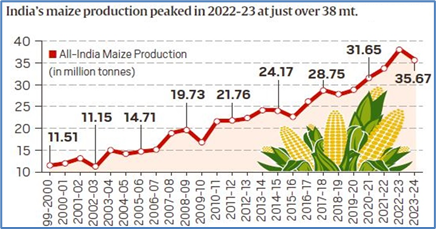Why in News?
India is a success story of the green revolution in maize driven by the private sector, with maize production having more than tripled over the past 20 years.
What’s in Today’s Article?
- Green Revolution in India
- Green Revolution in Maize
Green Revolution in India:
- About:
- The history of the Green Revolution in India goes back to the 1960s when high-yielding rice and wheat was introduced to increase food production.
- It was a period during which agriculture in India was converted into a modern industrial system by the adoption of technology, such as
- The use of high yielding variety (HYV) seeds,
- Mechanised farm tools,
- Irrigation facilities,
- Pesticides and fertilisers.
- Mainly led by agricultural scientist M. S. Swaminathan in India, this period was part of the larger Green Revolution endeavour initiated by Norman Borlaug -
- for increasing agricultural productivity in the developing world,
- by leveraging agricultural research and technology.
- Impact:
- Crop varieties can be chosen by breeding for a variety of beneficial traits, including high yields, resistance to disease, fertiliser responsiveness, and product quality.
- It resulted in an increase in food grain production (especially in Punjab, Haryana, and Western UP), reduction in imports (leading to self-sufficient), industrial development, rural employment generation, etc.
- Criticism: Despite its initial success, the Green Revolution was met with much controversy throughout India. This is mainly due to:
- Increased input cost: This resulted in the indebtedness of the small farmers due to increased borrowing to finance the change from traditional seed varieties.
- Environmental damage and reduced soil fertility: Due to excessive and inappropriate use of fertilisers and pesticides.
- Increased regional disparities: This is because the green revolution spread only in irrigated and high-potential rainfed areas.
- Largely limited to wheat and rice.
Green Revolution in Maize:
- Maize crop in India:
- In India, maize is principally grown in two seasons, rainy (kharif) and winter (rabi).
- Kharif maize represents around 83% of maize area in India, while rabi maize corresponds to 17% maize area.
- Among the maize growing countries, India ranks 4th in area and 7th in production, representing around 4% of the world maize area and 2% of total production.
- Maize production in India:

- There is another less celebrated revolution that has taken place in India.
- Between 1999-2000 and 2023-24, annual production of maize has more than tripled, with average per-hectare yields rising from 1.8 to 3.3 tonnes.
- Another feature of maize in India:
- Maize is a fuel crop rather than a feed crop. Less than 25% of the maize produced is consumed directly by humans.
- An estimated 60% goes as feed for poultry and livestock, which is indirectly consumed as food by households (as chicken, egg or milk).
- 14-15% of India’s maize utilisation is for industrial purposes. Maize grains have 68-72% starch, and 1-3% of other simple carbohydrates.
- Starch has applications in the textile, paper, pharmaceutical, food and beverage industries.
- The usage of maize as a feedstock for ethanol, which is mixed with petrol, is more recent.
- New varieties of maize:
- The Indian Agricultural Research Institute (IARI) has bred India’s first “waxy” maize hybrid with high starch content, making it better suited for ethanol production.
- The Mexico-based CIMMYT (International Maize and Wheat Improvement Center) has opened a maize doubled haploid (DH) facility at Kunigal, Karnataka.
- It produces genetically pure maize that can be used as parents for further crossing and breeding of hybrids.
- What advantage does maize have over wheat and rice?
- Rice and wheat are resistant to hybridization because they are self-pollinating plants, meaning that both the male and female reproductive organs are present in their flowers.
- This contrasts with maize, whose ability to cross-pollinate makes hybrid breeding a profitable endeavour.
- Role of private sector in green revolution in maize:
- More than 80% of India's maize crop is hybridised by the private sector.
- CIMMYT is sharing its improved inbred lines with both public sector institutions and 25-odd private seed companies.










